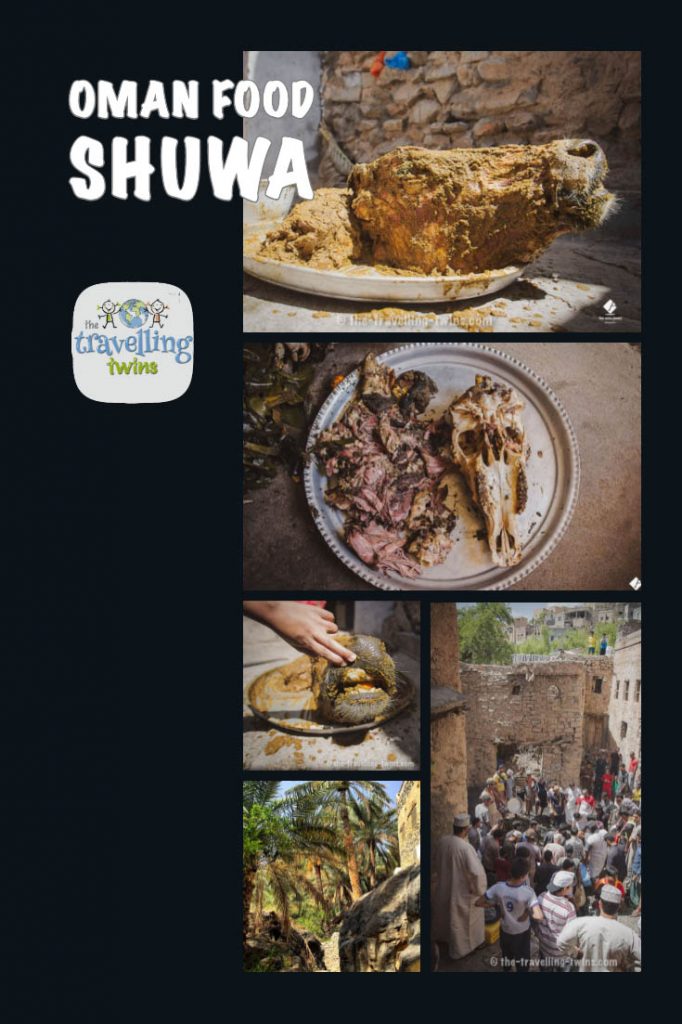
An Unexpected Invitation for Oman food on Eid
While we were living in Oman I ran a thriving business as a wedding photographer. One day I received an unusual request from a journalist from the UAE. Would I provide photos to illustrate her article on the Eid Al Adha celebrations in a small mountain village in Oman? It would involve two trips to the village with her. Of course I said yes. It didn’t take much to persuade us all to jump in our 4×4 and go exploring Oman in any circumstances. This was a chance to see a little into of the lives of the people who live in those beautiful mountains and also taste the Oman food.
Eid means religious feast. There are two Eids a year which compare in importance to the Christian Christmas and Easter. Eid al Fitr comes after the Holy Month of Ramadan – where all Muslim fast during the day. It is also known as the “Festival of Breaking the Fast”.
Eid al Adha honours Abraham’s willingness to sacrifice his son. Once he had proven his willingness to make the sacrifice, God allowed him to substitute a lamb. To celebrate this every year, Muslim families kill an animal. In line with tradition, they divide it into three – one third for charity, one for the home and the third part for their extended family. Our mission was to join and photograph one family in Misfat al-Abriyeen during this feast.
Misfat Al Abriyeen
Travelling from Muscat with my husband and the twins, we picked up our journalist and drove into the Hajar mountains. Gradually, the highways turned into small roads and those became more winding and dusty as they rose into the mountains. At Last, we turned a sharp bend and saw for the first time the beautiful little village which would come to fill such a special place in our memories. Misfat Al Abriyeen is not just a village but a verdant splash of green perched at 900m on the dusty sun-parched southern slope of the highest mountains in Oman. The village is the beneficiary of mountain springs which provide such an abundance of water that the village children could swim in it before it is distributed to sustain a network of tiny fields which cascade in terraces down the mountain slopes. Even banana trees thrive in the abundance of water in this place. Bananas were common a thousand kilometres away in the almost jungly southern corner of Oman, but we had never seen any fruit grow up here in the arid North other than date palms, mangoes and pomegranates and other exotic fruits.
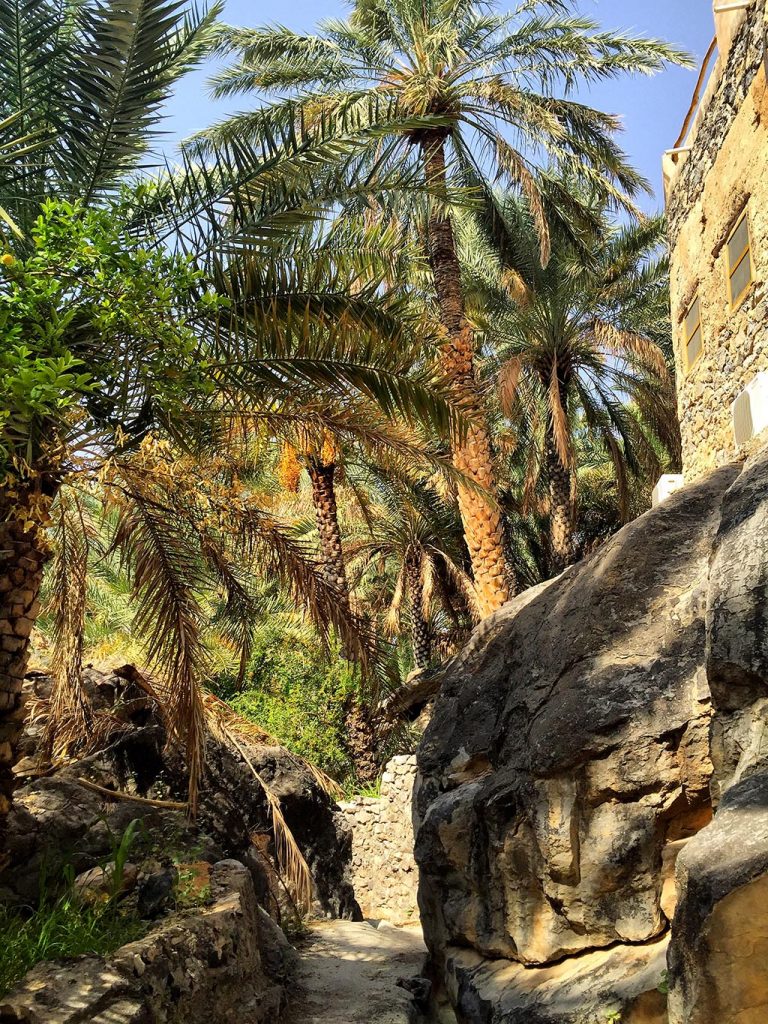
Read our post about this enchanting oasis in the middle of Hajar Mountains – Misfat al Abriyeen
The car park is at the highest point of the village. The town streets were below us. The greenery bubbled up like so much emerald cotton-wool from the valleys below that.
The Fire Master’s Majlis
We climbed down through the village until we passed out under an arch at the bottom of our path into the green. This is the place where the main horizontal Falaj of the irrigation network crosses the village. Here we turned left and walked along beside the water channel, following along the lower edge of the built-up area. In a hundred metres we turned left again. Then we entered through a tiny yard into the steps of one of the village houses. As is common in Oman, the main room of this house is entered not from within the private hallway but from its own door opening direct from the fresh air. This room is known as the Majlis. The daughter of the house ushered us in to meet the Fire Master. He was old and blind. The fire master told us of his life as caretaker for the village mosque. He also shared about his thirty-year tenure as keeper of the Shuwa (Oman food) fire pit.
Shuwa
Shuwa is Oman food in which meat is slow-cooked underground in the embers of a fire for several days. But it is much more than that. It is a traditional celebration of the feast made with family and friends. We were here for the first day of Eid and the Fire Master’s extended family were butchering the steer which they had bought two years earlier and had killed that morning. The house is on three levels above the Majlis. We climbed up to the roof, passing the young men of the family who were cutting up the carcase with saws and axes. Pieces of meat and bone were hanging from the balustrades around the stairwell. The women were preparing various kinds of offal preserves and stringing them from the rafters.
An Ox Head on a Plate
On the roof terrace the animal’s skinned head was already lying in state, smeared in a thick oily paste of spices prepared to the family’s secret recipe. An orange was stuffed in its mouth. The gruesome head was wrapped in banana leaves and bundled up into a jute sack. This was the Oman food delicacy which we would be sharing when it was dug up two days later. It was one of the weirdest food in the world

The Communal Fire Pit
About 40 families share one communal fire pit located in an open courtyard accessible from a steep stepped road nearby. There aren’t that many peoples still living in the old village, but families return here for the Eid shuwa tradition. Each sack was labelled with some distinctive metal object. They were placed into the pit where a fire of palm tree trunks had been burning. It was lined with hot embers. The pit was covered with earth, and the families returned to their houses, some in the village and some much farther afield. We too went home.
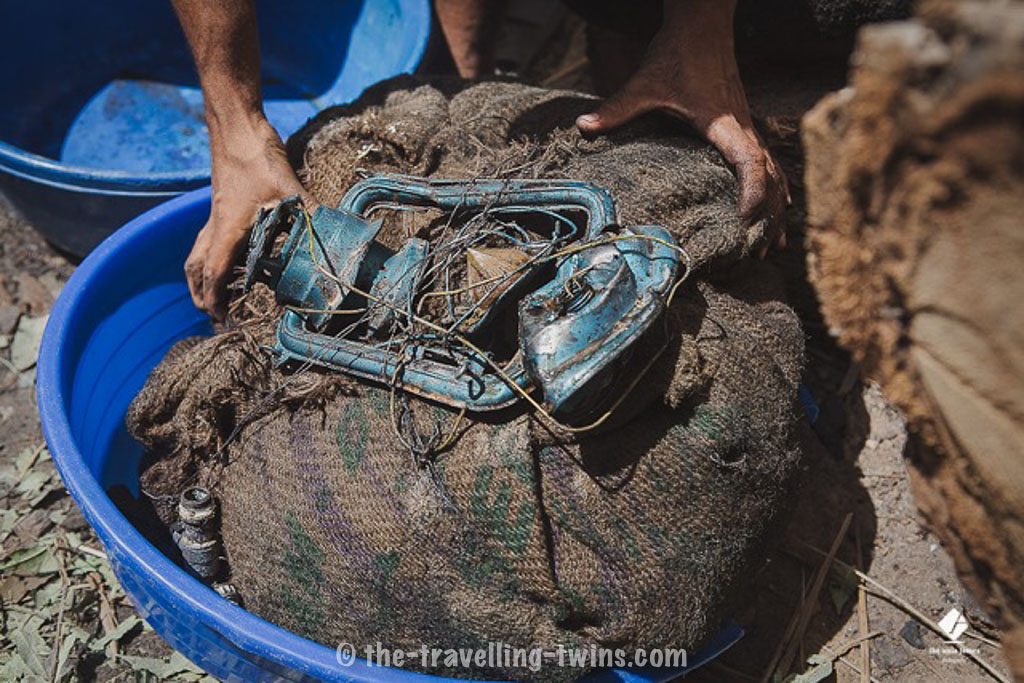
The Exhumation
Two days later we again met the journalist and drove out together to Misfat. A group of young men were drumming in the arches of the old village cobbled streets. They welcomed us to join them, lending us a hand-drum. Others were gathering in the square waiting for midday prayers after which the pit could be opened.
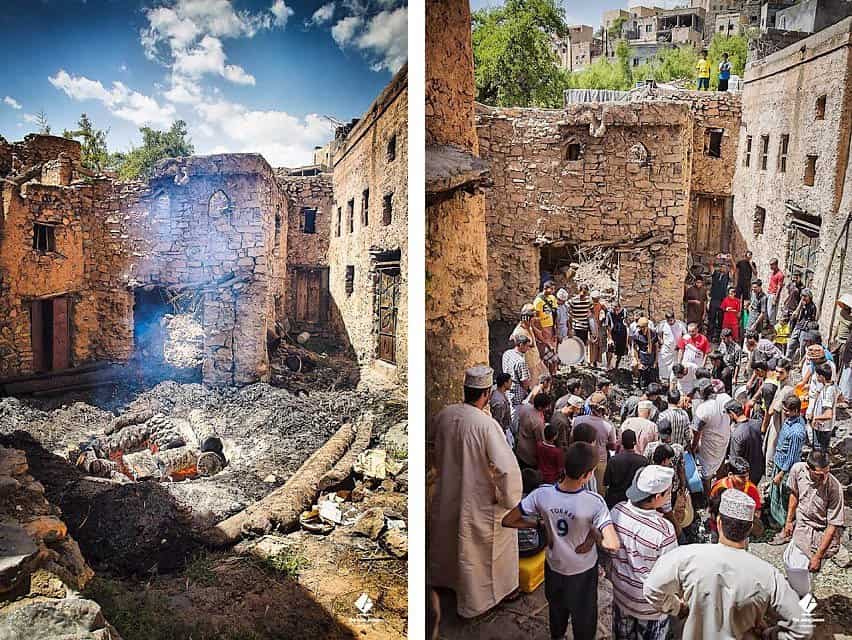
By the time the digging started the tiny courtyard was crowded. The buildings surrounding it are now derelict, but there are old terraces and balconies which provided perches for us and fifty or sixty other spectators, nearly all of them, members of the local families who had some parcel in the firepit.
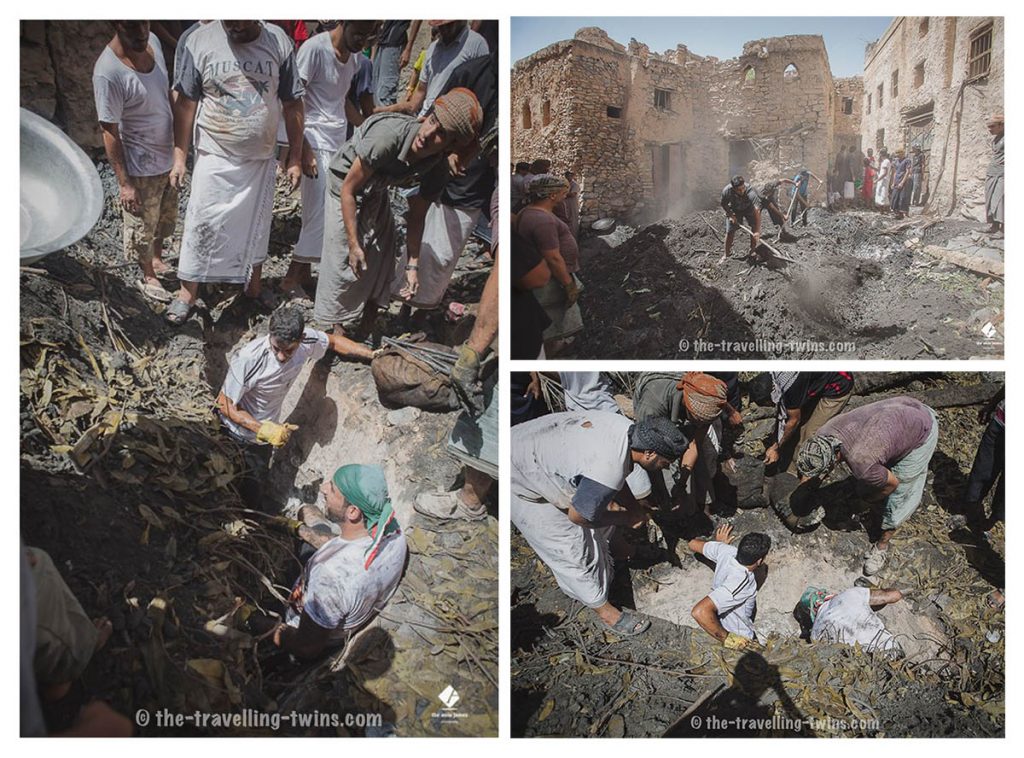
It was a heavy and dirty job to exhume all the bundles, but at last they were all recovered and distributed back to their owners. The young men of the Fire Master’s family carried our package back to the house where we had witnessed its preparation two days earlier. Now the house was no longer decorated with animal body parts. A mat was spread on the floor of one of the upper rooms and we were invited to sit and share the Oman food feast.
The Feast
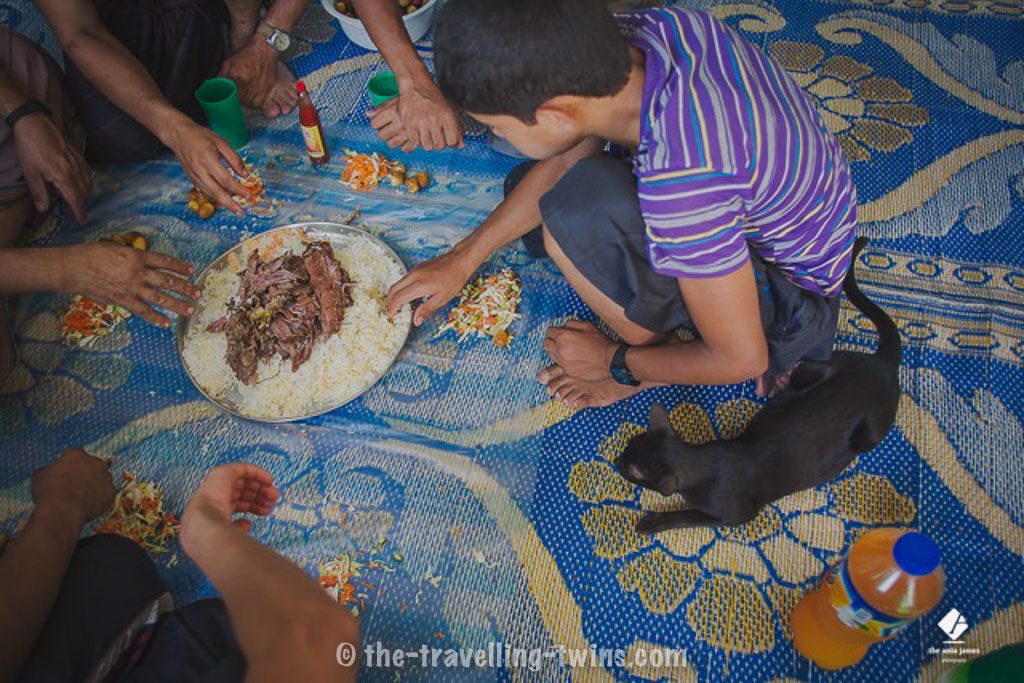
It was a happy friendly Oman food meal. We were more than a little curious to see whether the terrible severed head would be edible but determined to try it nonetheless. We needn’t have been concerned. The meat was both delicious and tender. After that, we tried the shuwa (Oman food) which you find on the menu of several Omani restaurants back home in Muscat. Generally, this is a rack of slow-cooked goat ribs served in aluminium foil. It was always tender and tasty, but none compared with the magic of the Eid feast we ate that day in Misfat Al Abriyeen.
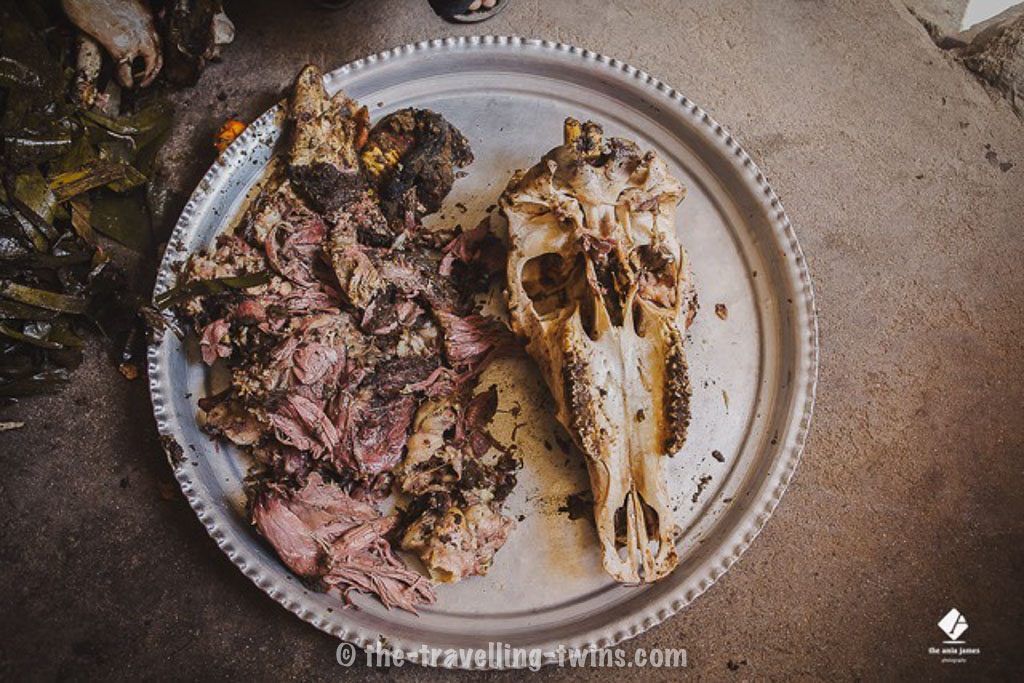
This is an amazing story! I’ve traveled to Muscat and loved it. The people were so kind and the region is just gorgeous. However this experience is so special and something I would love to experience. Thanks for sharing.
I really enjoyed reading this 🙂
What an amazing experience living in Oman and learning about the culture!
What an amazing experience to have, it is interesting to know that they put the food 2 days underground, it must have been delicious! Thank you for sharing your experience.
Oman was one of the most exotic and friendly places we have lived. And being part of Eid celebration when we tried Ox head was one of these moments you never forget